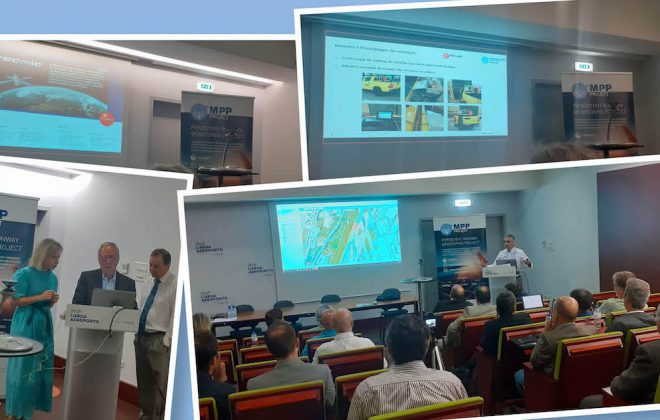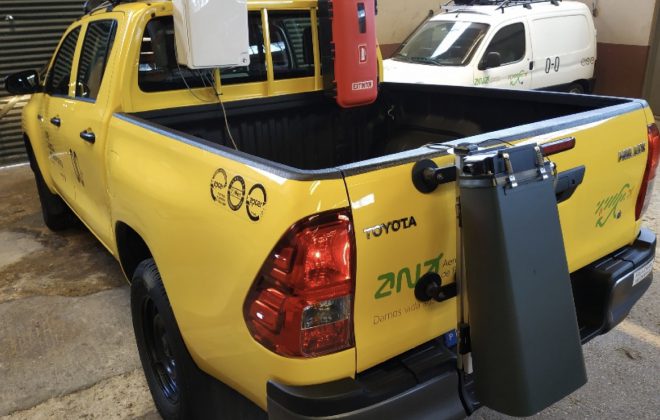Visit to Lisbon airport to specify the vehicle onboard equipment
As part of the specification of the on-board equipment, which allows adapting the XTRANTM platform to the objectives of the MPP Project and integrating the road sensor (spectral sensor, capable of detecting the characteristics of water sheets), TECMIC visited the Airport Humberto Delgado in Lisbon. The work carried out consisted of an in situ survey of the characteristics of the vehicles used. The final objective is to integrate the on-board system (XTRANTM Unit + MARWIS Sensor + HMI Console) in the vehicle, studying its impacts on what will be the final MPP solution.
It should be noted that the work was carried out in the current exceptional context of a pandemic caused by the Covid-19 virus, with the repercussions that were verified in the project.
In view of this new reality, there was a change in the activities planned to be carried out on the airside of Humberto Delgado Airport, resulting in some delay in the execution of the MPP Project.
Naturally, the measures implemented had a very strong impact on the circulation of elements and accesses to the airside, which includes runways, which are the subject of the MPP study, despite the reduction in operations at the airport.
Despite the mentioned constraints, the project teams completed the work of measuring and surveying the characteristics of the vehicles and their use on the runway.
Following this task, the sensor will be calibrated and interacted with the XTRANTM embedded system. Vehicle installation conditions and the distance to the ground problem will also be studied. The outputs of the studies will be used in the development of the necessary hardware for the integration of the chosen sensor in the XTRANTM platform.
Given that the consortium has an extensive experience in remote monitoring and embedded systems, it was decided to choose a more robust road sensor with the capacity to carry out the analysis of some parameters in relation to the conditions of the road pavement. In MPP, this component will be an intelligent IoT (Internet of Things) road sensor. This sensor will allow the user to easily collect “punctual” information on the state of the road (or runway in the case of aviation) in addition to collecting data on other parameters (eg temperature, humidity and friction, including the presence of ice and snow, allowing its use in places with different meteorological characteristics).
With the execution of this task, Tecmic will integrate the sensor data in the XTRANTM platform to which metadata will be added (e.g. georeference information and the associated time – timestamp). The GSM / GPRS transmission system will be responsible for transmitting the data to the central platform. The consortium will also address the entire process of formatting the acquired data and the difficulties to achieve reliable communication.
The use of a road sensor based on optical spectroscopy technology, installed in a vehicle, is used to streamline the LIDAR 3D sensor calibration procedure (installed at an observation point, in line with the touch zone, or placed in a specific zone, in the case of a road). This calibration procedure applies only to the water sheets characterization feature to be performed by the LIDAR 3D sensor. It is estimated that this calibration process will be carried out sporadically, and based on strict planning in conjunction with the Airport Operations Services, as well as using the system embedded in the support vehicle in order to minimize the duration of this process, and thus the project does not foresee any operational constraints on the runway at Humberto Delgado Airport.
The Persistent Runway Monitoring (MPP) project addresses an innovative solution for monitoring and analyzing runway status in airports, even in adverse weather conditions.
In the activity, related to the design and development of the solution, hardware and code of the various components, modules, services and features of the solution, all developments will be accompanied by review, changes and improvements compared to what was initially planned and specified. During the development phase, testing some modules / features requires not only laboratory testing, but field-testing as well. Because of the pandemic situation, as previously mentioned, these had to be rethought and replanned, resulting in a delay in their realization.
The development of event monitoring and analysis modules on the runway (3D scanning) in a semi-automatic mode is based on the information collected through a 3D laser sensor, providing the detection and characterization needs in a semi-automatic way: Detection of floor deformation; Detection of FODs and Detection of water on the runway.
In addition to all the restrictions on access to the airside of the airport, the purchase of LIDAR equipment, used for this activity, also experienced a strong delay as a result of restrictions on the circulation of materials / equipment between countries, namely between Portugal and Spain, country of origin of the equipment.
Since the beginning of the pandemic, the teams of ANA, INOV and TECMIC have been able to adapt to the constant changes that face them, forcing the consortium to change processes and planning, reflecting the agility and commitment of all stakeholders, but continuously observing all safety rules stipulated by DGS and ANA, SA, maintaining and ensuring the good direction of the MPP Project.
In addition to the challenges arising from the pandemic situation in 2020, those of 2021 will be added. The recovery of the delay observed in the execution of some activities of the MPP Project still seems uncertain, due to the lack of knowledge about the evolution of Covid-19. However, moving forward is as necessary as it is indispensable, in order to successfully achieve the results of the MPP Project.
In this way, the MPP Project team continues to work hard, to do more and better in all activities: plans are reviewed and changed, readjusting the work at the airport, looking for new and innovative solutions, to address the constraints arising from the pandemic situation.




